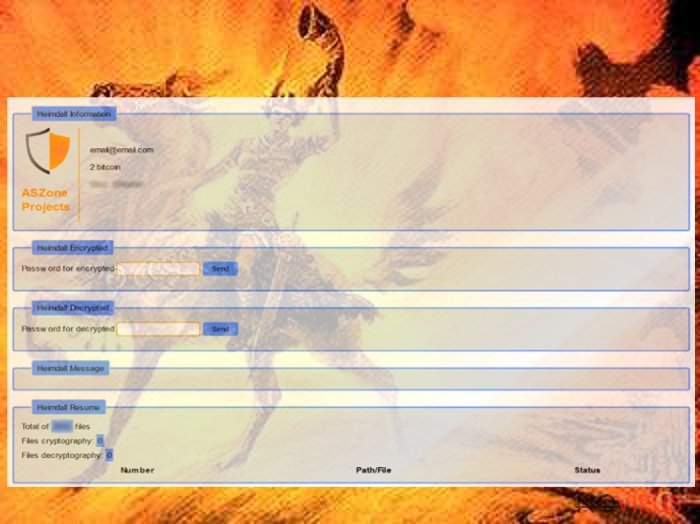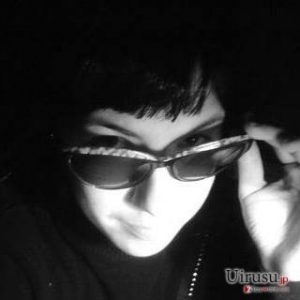Uninstall Heimdall virus (Nov 2016 updated) - Uninstall Instructions
Heimdall virus Removal Guide
Description of Heimdall ransomware virus
What to expect from Heimdall ransomware virus?
The developers of ransomware usually remain secret; however, we already know who has released Heimdall virus. This piece of malware has been created by Brazilian developer Lenon Leite. Malware has been spotted on GitHub at the end of October 2016, where it has been presented as a project. It seems that ransomware has been created for ‘educational’ purposes and put under the MIT licence. Heimdall ransomware belongs to the ransomware category coded in PHP language. According to various IT specialists and malware analysts, this malware is not expected to become a global threat. However, the detailed report about it may inspire other hackers and malware creators to develop similar cyber threats.
Heimdall virus is designed to target various file types such as documents, images, video and audio files, databases, archives and even system components. It encrypts all these files using unique AES-128-CBS algorithm and appends .heidmall file extension to the encrypted data. Once it finishes encoding files, it delivers ransom note and informs victims what have happened to their files and how they can restore them. Similarly to other ransomware-type viruses, the developer demands to pay the ransom. Victims are supposed to pay 2 Bitcoins within two days, and after the payment, they will receive a necessary password to decrypt files. Even though the virus is more than a prototype than an actual ransomware, some computer users inform about the infection. Therefore, if you have encountered this ransomware, do not consider transferring money because you may end up with an even bigger loss. Instead of paying the ransom, initiate Heimdall removal. We do not recommend trying to eliminate malware manually because you may accidentally delete necessary system files. Employ FortectIntego, SpyHunter 5Combo Cleaner or other reputable malware removal utility and run a full system scan with an updated program. Professional anti-malware programs can detect and remove Heimdall and other computer infections within several minutes.

Tips to avoid ransomware
Malware analysts claim that wide Heimdall malware distribution is not expected. Ransomware has been spotted on GitHub. Even though the developer was asked to remove his application, it still appears there. It seems that the developer is not willing to launch huge ransomware campaign; however, other virus developers may use its code and launch updated malware attack. In this situation, the only thing you can do is to protect your computer and personal data. Malware distribution techniques stay the same: malicious spam email campaigns, malware-laden ads, drive-by installations and exploit kits. Computer users should take some precautions to reduce the risk of ransomware attack. First of all, regularly make data backups and store them in external devices. Secondly, install reputable antivirus tool and keep all your programs updated. Thirdly, stay away from suspicious emails that express the urgent need to open the attachment. Even though the message author claims to be from a reliable institution, government or financial company, double check the information about him online or contact the institution directly. Keep in mind that virus executable may hide even in innocent looking Word document. Lastly, avoid clicking suspicious ads, visiting high-risk websites or installing questionable software from unknown sources. In other words, behave responsibly while browsing the Internet.
Heimdall removal suggestions
The risk of Heimdall attack is low; however, if your computer got infected with it, you have to concentrate on its removal. There’s no need keeping malware inside because it may cause more problems and will make your computer even more vulnerable. When computer lacks protection or is infected, other malware or ransomware viruses can easily get inside and ask you to pay even more money for encrypted files. Remove Heimdall with a help of FortectIntego, SpyHunter 5Combo Cleaner or Malwarebytes. These anti-malware tools will remove malware along with all its malicious components. However, if you face some difficulties, follow the instructions below. After Heimdall removal, restore your files from backups or try additional data recovery methods presented below.
Getting rid of Heimdall virus. Follow these steps
In-depth guide for the Heimdall elimination
Important! →
The elimination guide can appear too difficult if you are not tech-savvy. It requires some knowledge of computer processes since it includes system changes that need to be performed correctly. You need to take steps carefully and follow the guide avoiding any issues created due to improper setting changes. Automatic methods might suit you better if you find the guide too difficult.
Step 1. Launch Safe Mode with Networking
Safe Mode environment offers better results of manual virus removal
Windows 7 / Vista / XP
- Go to Start.
- Choose Shutdown, then Restart, and OK.
- When your computer boots, start pressing the F8 button (if that does not work, try F2, F12, Del, etc. – it all depends on your motherboard model) a few times until you see the Advanced Boot Options window.
- Select Safe Mode with Networking from the list.

Windows 10 / Windows 8
- Right-click the Start button and choose Settings.

- Scroll down to find Update & Security.

- On the left, pick Recovery.
- Scroll to find Advanced Startup section.
- Click Restart now.

- Choose Troubleshoot.

- Go to Advanced options.

- Select Startup Settings.

- Press Restart.

- Choose 5) Enable Safe Mode with Networking.
Step 2. End questionable processes
You can rely on Windows Task Manager that finds all the random processes in the background. When the intruder is triggering any processes, you can shut them down:
- Press Ctrl + Shift + Esc keys to open Windows Task Manager.
- Click on More details.

- Scroll down to Background processes.
- Look for anything suspicious.
- Right-click and select Open file location.

- Go back to the Process tab, right-click and pick End Task.
- Delete the contents of the malicious folder.
Step 3. Check the program in Startup
- Press Ctrl + Shift + Esc on your keyboard again.
- Go to the Startup tab.
- Right-click on the suspicious app and pick Disable.

Step 4. Find and eliminate virus files
Data related to the infection can be hidden in various places. Follow the steps and you can find them:
- Type in Disk Cleanup in Windows search and press Enter.

- Select the drive (C: is your main drive by default and is likely to be the one that has malicious files in) you want to clean.
- Scroll through the Files to delete and select the following:
Temporary Internet Files
Downloads
Recycle Bin
Temporary files - Pick Clean up system files.

- You can also look for other malicious files hidden in the following folders (type these entries in Windows Search and press Enter):
%AppData%
%LocalAppData%
%ProgramData%
%WinDir%
After you are finished, reboot the PC in normal mode.
Eliminate Heimdall using System Restore
-
Step 1: Restart your computer in Safe Mode with Command Prompt
Windows 7 / Vista / XP- Go to Start → Shutdown → Restart → OK.
- As soon as your computer starts, start pressing F8 key repeatedly before the Windows logo shows up.
-
Choose Command Prompt from the list

Windows 10 / Windows 8- Click on the Power button at the Windows login screen, and then press and hold Shift key on your keyboard. Then click Restart.
- Then select Troubleshoot → Advanced options → Startup Settings and click Restart.
-
Once your computer starts, select Enable Safe Mode with Command Prompt from the list of options in Startup Settings.

-
Step 2: Perform a system restore to recover files and settings
-
When the Command Prompt window appears, type in cd restore and press Enter.

-
Then type rstrui.exe and hit Enter..

-
In a new window that shows up, click the Next button and choose a restore point that was created before the infiltration of Heimdall and then click on the Next button again.


-
To start system restore, click Yes.

-
When the Command Prompt window appears, type in cd restore and press Enter.
Bonus: Restore your files
Using the tutorial provided above you should be able to eliminate Heimdall from the infected device. novirus.uk team has also prepared an in-depth data recovery guide which you will also find above.There are a couple of methods you can apply to recover data encrypted by Heimdall:
Restore files using Data Recovery Pro tool
Data Recovery Pro is an useful tool that helps to recover deleted, corrupted or encrypted files. To use this program, follow the steps below:
- Download Data Recovery Pro;
- Install Data Recovery on your computer following the steps indicated in the software’s Setup;
- Run the program to scan your device for the data encrypted by Heimdall ransomware;
- Recover the data.
Restore files using ShadowExplorer
If ransomware hasn’t deleted Volume Shadow Copies, ShadowExplorer will help you to restore some of the lost files.
- Download Shadow Explorer (http://shadowexplorer.com/);
- Install Shadow Explorer on your computer following the instructions in the software’s Setup Wizard;
- Run the program. Navigate to the menu on the top-left corner and select a disk containing your encrypted files. Look through the available folders;
- When you find the folder you want to recover, right-click it and select “Export”. Also, choose where the recovered data will be stored.
It is strongly recommended to take precautions and secure your computer from malware attacks. To protect your PC from Heimdall and other dangerous viruses, you should install and keep a powerful malware removal tool, for instance, FortectIntego, SpyHunter 5Combo Cleaner or Malwarebytes.
How to prevent from getting ransomware
Securely connect to your website wherever you are
Sometimes you may need to log in to a content management system or server more often, especially if you are actively working on a blog, website, or different project that needs constant maintenance or that requires frequent content updates or other changes. Avoiding this problem can be easy if you choose a dedicated/fixed IP address. It's a static IP address that only belongs to a specific device and does not change when you are in different locations.
VPN service providers such as Private Internet Access can help you with these settings. This tool can help you control your online reputation and successfully manage your projects wherever you are. It is important to prevent different IP addresses from connecting to your website. With a dedicated/fixed IP address, VPN service, and secure access to a content management system, your project will remain secure.
Reduce the threat of viruses by backing up your data
Due to their own careless behavior, computer users can suffer various losses caused by cyber infections. Viruses can affect the functionality of the software or directly corrupt data on your system by encrypting it. These problems can disrupt the system and cause you to lose personal data permanently. There is no such threat if you have the latest backups, as you can easily recover lost data and get back to work.
It is recommended to update the backups in parallel each time the system is modified. This way, you will be able to access the latest saved data after an unexpected virus attack or system failure. By having the latest copies of important documents and projects, you will avoid serious inconveniences. File backups are especially useful if malware attacks your system unexpectedly. We recommend using the Data Recovery Pro program to restore the system.







